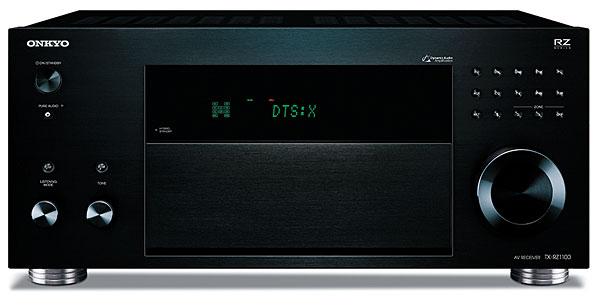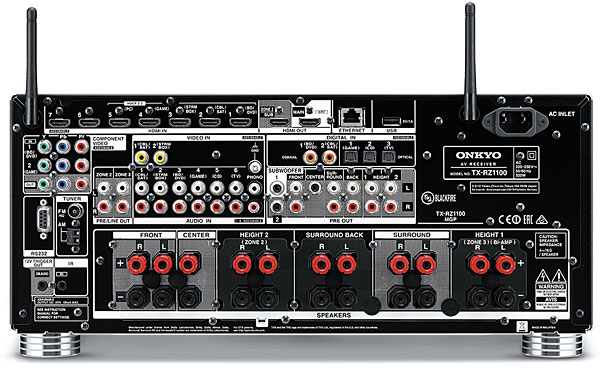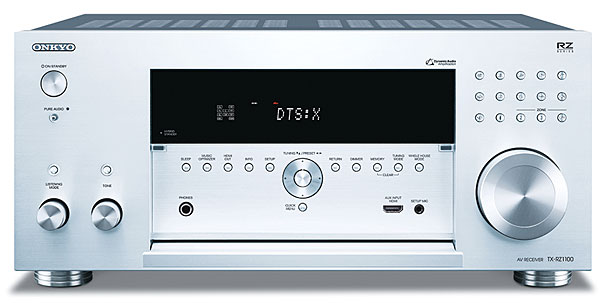...it must be a Pioneer Elite.
Onkyo TX-RZ1100 A/V Receiver Review

AT A GLANCE
Plus
Impressively dynamic, generous nine-channel power
Dolby Atmos, DTS:X on board
THX Select2 certified
Minus
Meh remote
Ocassionally unintuitive ergonomics
Some features still await firmware update
Premium pricing
THE VERDICT
This Onkyo has faultless amplification and solid usability, though you’ll pay extra for it.
Onkyo must not have gotten the memo about Class D–powered audio gear being smaller, svelter, lighter. The company’s new topmodel-but-one TX-RZ1100 is an imposing object 8 inches tall, and while the receiver’s 43-pound weight poses no challenge to the seemingly 100-pounders of yesteryear, it’s not exactly nothing, either.
Nevertheless, the newest Onkyo is indeed a Class D design. The marketing materials refer to it as “Onkyo High-Current Digital Amplification,” which raises my hackles slightly since Class D isn’t “digital” in the digital-audio sense, but that is discussed in my recent online article about amplifiers (found at soundandvision.com). The TX-RZ1100 does have, however, a fully nine-channel layout, rated at 140 watts each with channels driven in pairs. That’s a lot of pretty substantial channels for any receiver, whatever the topology, and it explains both the unit’s overall heft and the weighty-on-its-own, rather un-Class-D-like power transformer I found residing inside.
The TX-RZ1100 presents Onkyo’s next-gen front-panel layout, with most controls in a 3x5 grid of pushbuttons to one side (the right, with the unthinking discrimination against the left-handed minority, a practice so common in industrial design). Below is a huge knob for volume; on the other side are two smaller ones, each with an associated button, for listening mode and tone control. Audio elders like myself are liable to grab those smaller knobs and twist without first pushing the associated button, wondering why the bass and the treble aren’t changing—especially given that the tiny identifying graphics are all but invisible without Holmesian flashlight (er, torch) and magnifying glass. Onkyo retains from earlier models a massive drop-down door revealing the remaining controls and jacks, something that A/V receiver makers apparently agreed upon collectively years ago as a design requirement.
Rack It
Unboxing and installing the TX-RZ1100 made no special demands other than exercising a bit of care in doing the clean-and-jerk to get it atop my long-suffering equipment rack. Onkyo’s design incorporates a pair of legacy composite-video inputs (but no corresponding output; the receiver transcodes to component video or HDMI). Not surprisingly today, it does not incorporate any S-video paths. One thing you will find, however, are full 11.2-channel preamp outputs, which would allow the TX-RZ1100 to drive a 7.2.4 Atmos/DTS:X system with an additional outboard stereo amplifier. Another connectivity note: Onkyo chose European safety-standard-compatible spacing for the medium-duty multi-way posts used for all channels’ speaker outputs, which means that U.S.-style, 0.75-inch dual-bananas don’t fit.

Rats. Nevertheless, I connected my 5.1.4-channel, Dolby Atmos–ready speaker layout, which includes a pair each of “ceiling-bounce” elevation modules for the front and the rear, without other incident. I then plugged in my source and screen HDMI cables and moved on to auto setup.
Onkyo, like several other brands, has abandoned Audyssey MultEQ setup/equalization options in favor of the company’s own proprietary technology, dubbed AccuEQ. This proceeds along similar lines: There’s a supplied mini-microphone you plug into the receiver and place at the listening position, which collects speaker- and room-response data from the internally generated clicks and noise bursts the receiver then emits. Onkyo’s onscreen prompts and graphics are simple and easily followed. However, there’s no display, either tabular or graphical, of the corrections thus derived. And whereas Audyssey collects data from as many as 8 or even 16 different mic positions, depending on the level of MultEQ (each with, presumably, a corresponding level of licensing fee), AccuEQ, at least as implemented in the TX-RZ1100, takes measurements from only one position at the primary listening chair. I am not enough of an acoustician or a digital-filter designer (not hardly!) to damn or bless either system. But my general sense, absorbed from those who know a lot more than me (admittedly, not terribly difficult), is that the more positions you measure from, the larger the area over which you obtain a picture of room effects you can potentially calculate and thus attempt to correct.
In my room, which acoustically is pretty good to begin with, AccuEQ’s effect was fairly subtle. On the top end, the process yielded a very slightly brighter impression, or perhaps a touch more focus or sharpness on treble-rich elements like percussion, strings, and brass. In the lower octaves, AccuEQ made a more noticeable difference, raising the level of and tightening the bottom octave and a half or so, in a fashion I found pleasing at my preferred subwoofer level, which is usually a few decibels below “flat”; if I left the sub at the 0-dB point determined by the auto setup, this was a bit too rich for my taste. In any case, since the impact of any auto EQ will always be hugely dependent on the room and the system, I performed the bulk of my evaluations with it defeated, as I always do.
Track It
Otherwise, on the sound quality front, the TX-RZ1100 scored very high marks. As customary, I started out auditioning the receiver in two-channel full-range mode, with my Energy Veritas 2.2 monitors flying solo (well, duo). Here, I found the Onkyo’s overall presentation to be nicely detailed, especially on transients like cymbals or brass attacks, and capable of ample definition on even the most complex music. The Yoichi Murata Orchestra’s Compositions (96/48 FLAC) is one of my go-to reference recordings for detail and dynamics. On this receiver, the big-band attack was outstanding, with solid soundstage depth, palpable transient air, and sharply etched textures all in evidence.

I was impressed by the Onkyo’s dynamic output in every mode, including multichannel music. A recording like Bobby Womack’s Soul Sensation Live (96/24, on an ancient DVD-Audio disc from Silverline) makes significant demands in almost every octave, yet it sounded open and easily punchy, especially on an up-tempo track like “Inherit the Wind.” Bottom-end grunt was impressive, too. My little Energys go solidly to below 40 hertz, so the system still had plenty of output there to paint an honest picture. Returning to full-range stereo, I cued up the peerless Bonnie Bramlett and her cover of “Cry Me a River” (an HDtracks HRA file), listening for the D-extension double bass. The lowest note on a bass viol is usually E-natural at about 41 Hz. But with the extension, it goes down to E-flat at about 36 Hz—and through the Onkyo, it sounded gorgeously full, woody, rich, and vibrant. All of this is noteworthy because these Energys love power. They sound fine with an honest 65 watts, but the more (and more dynamic) power you feed them, the better and higher-end they sound, and the TX-RZ1100 met the challenge.
As for movies: same deal, only more so. After checking my usual rotation of scenes and finding no problems with dialogue quality, surround integrity, or dynamic ability, I cranked up the Atmos soundtrack of Star Trek: Beyond. I stopped at 4 dB below the THX cinema reference because ref level is simply too damned loud in my room—and even this was a few decibels louder than my usual preference, even for big-action movies. (Oh, the sacrifices I make in the name of science.) As an aside, this umpteenth Trek flick looked downright fabulous upscaled to 4K by my Oppo BDP-105D (with my chair moved up to about 6 feet from my 55-inch screen), especially in the countless ridiculously elaborate sets, both physical and CGI. But can someone explain why all the aliens’ makeup looked so Halloween-store rubber-mask cheesy? A conscious throwback to the original TV show? Or simply the limitations of physical versus virtual modeling? I’d like to know.
- Log in or register to post comments


at over 43 lbs this supposed 140wattx2 (125watts in reality ) weighs 10 lbs heavier then an sc95 and puts out less power is there a brick hidden inside and you'ld think if they were going to use the d3 amps maybe they should have used the EQ as well it would have made more sense then developing something that took everybody else years to do before they got it right

Good review. I recently got the TX RZ810 and whole heartedly agree with your review. The sonic signature you describe is exactly what I hear with the 810. I've had a whole slew of amps and receivers and this one is unique. Detailed, powerful, and clear. Yes clear. For some reason this amp just sounds clear. The measurements for the 1100 show a 1 db high frequency boost which I seem to hear in the 810 as well I wouldn't describe this amp as bright, but it does lean to that side ever so slightly. Great amp the 810 and probably gonna buy the 1100 for my other place. Sounds awesome. Running the 810 on Klipsch RP 260, RP 250 and RP 440C btw. Good movie set up and reasonably priced.

Sadly the A/V receiver will soon become a specialty niche product, just as separate components are now (pre-amp/processor and Amplifiers).
That is to say only dedicated videophiles will be on the market for them.
A decent desktop in the near future will be able to do all the processing that a good A/V does now. It is the Amplifier that will continue to live in some new iteration as part of any A/V system.
A/V receivers are simply highly over priced considering that good speakers and source players are affordable in comparison.

I recently purchased the Integra DRC-R1 Pre/Pro which is also an Onkyo product.
Am very happy with the sound but It has the same very poor online manual. I have contacted Integra to find out if there is a more complete manual available. They say that there isn't one.
The remote is also very basic for this level of product and is not backlit.
Very frustrating!

This review belongs in the "Electronics/AV Receivers" section, not in the "Displays/4K Ultra HD TV" section of the reviews. I actually had to find this review on Google because it isn't listed in the proper section.





































































